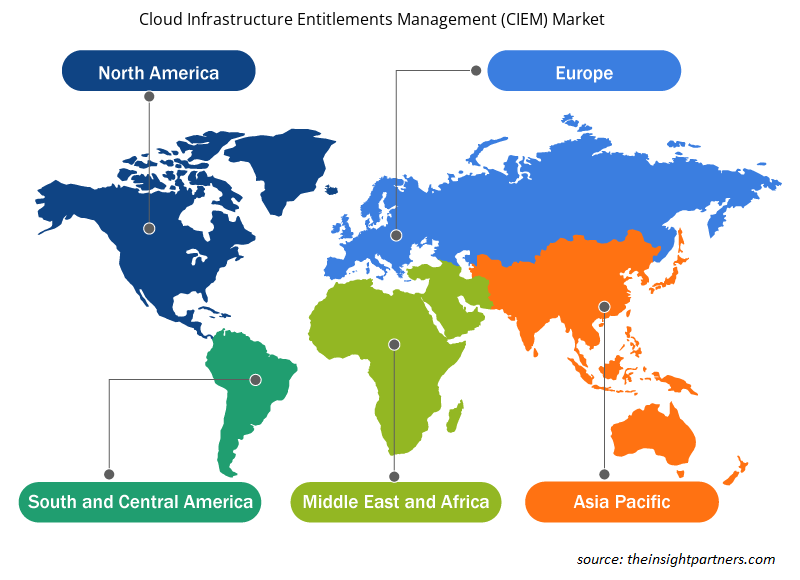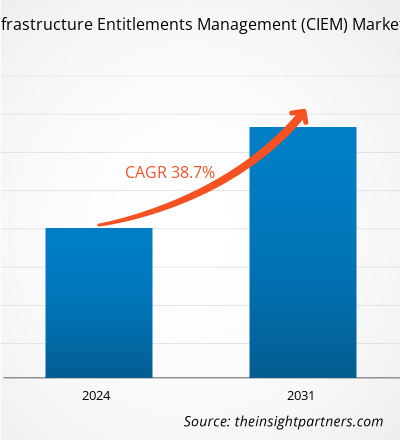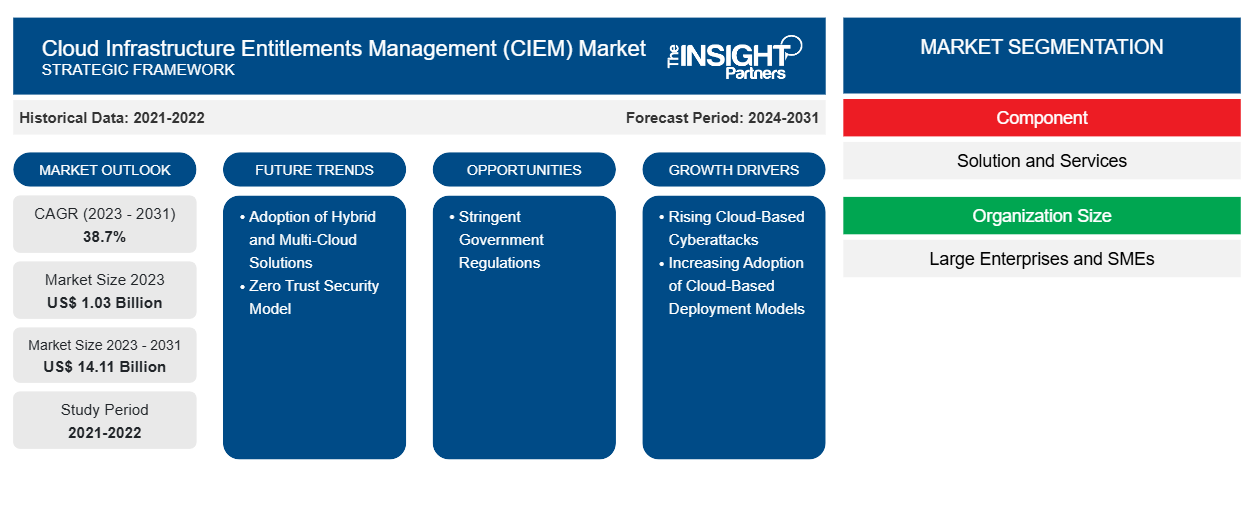Es wird erwartet, dass der Markt für Cloud Infrastructure Entitlements Management ( CIEM ) von 1,03 Milliarden US-Dollar im Jahr 2023 auf 14,11 Milliarden US-Dollar im Jahr 2031 anwächst. Für den Markt wird für den Zeitraum 2023–2031 eine durchschnittliche jährliche Wachstumsrate (CAGR) von 38,7 % erwartet. Es werden wahrscheinlich neue Trends auf den Markt kommen.
Marktanalyse für Cloud Infrastructure Entitlements Management ( CIEM )
Der Bedarf an Cloud Infrastructure Entitlements Management ( CIEM ) wird durch die wachsende Notwendigkeit für Unternehmen getrieben, ihre Cloud-Sicherheit zu verbessern. Die zunehmende Nutzung von Cloud-Lösungen und -Diensten, digitale Transformationsprojekte und eine erhöhte Anzahl von Cloud-basierten Cyberangriffen sind einige der Faktoren, die den Markt antreiben. Die COVID-19-Pandemie veranlasste viele Unternehmen, von On-Premise- auf Cloud-Computing umzusteigen, was zu einer Expansion des Marktes für Cloud Infrastructure Entitlements Management ( CIEM ) führte . Der Bericht enthält Wachstumsaussichten aufgrund der aktuellen Markttrends für Cloud Infrastructure Entitlements Management ( CIEM ) und ihrer vorhersehbaren Auswirkungen während des Prognosezeitraums.
Marktübersicht für Cloud Infrastructure Entitlements Management ( CIEM )
Cloud Infrastructure Entitlements Management ( CIEM ) oder Cloud Entitlements Management-Lösungen oder Cloud Permissions Management-Lösungen sind Cloud-Sicherheitslösungen , die das Risiko von Datenlecks in öffentlichen Cloud-Umgebungen mindern. Cloud Infrastructure Entitlements Management-Lösungen wurden speziell dafür entwickelt, Berechtigungen in komplexen und dynamischen Umgebungen streng und konsistent zu verwalten. Cloud Infrastructure Entitlements Management-Lösungen überwachen kontinuierlich die Berechtigungen und Aktivitäten von Entitäten, um übermäßige Berechtigungen zu verhindern. Die Hauptfunktionen von CIEM sind Berechtigungstransparenz, Rechteverteilung bei Berechtigungen, erweiterte Analysen und Compliance.
Passen Sie diesen Bericht Ihren Anforderungen an
Sie erhalten kostenlos individuelle Anpassungen an jedem Bericht, einschließlich Teilen dieses Berichts oder einer Analyse auf Länderebene, eines Excel-Datenpakets sowie tolle Angebote und Rabatte für Start-ups und Universitäten.
- Holen Sie sich die wichtigsten Markttrends aus diesem Bericht.Dieses KOSTENLOSE Beispiel umfasst eine Datenanalyse von Markttrends bis hin zu Schätzungen und Prognosen.
Markttreiber und Chancen für Cloud Infrastructure Entitlements Management ( CIEM )
Zunahme Cloud-basierter Cyberangriffe
Die Einführung von Cloud Computing hat in den letzten Jahren mit wichtigen Akteuren wie Amazon, Google und Microsoft enorm an Bedeutung gewonnen. Cloud Computing hat die Art und Weise verändert, wie Unternehmen Daten und Informationen verwenden, speichern und weitergeben. Alles, was digital funktioniert, wird jedoch unweigerlich zum Ziel von Cyber- Akteuren. Die Verlagerung der Organisationen hin zu Cloud Computing hat Cyberkriminellen neue Möglichkeiten eröffnet , Schwachstellen auszunutzen, Daten zu kompromittieren und in Organisationen jeder Größe Chaos anzurichten. In der Cloud-Umgebung gespeicherte Daten sind anfälliger als Daten auf Servern vor Ort. Fehlkonfigurationen , kompromittierte Benutzerkonten, API-Schwachstellen, böswillige Insider-Aktivitäten und andere gehören zu den Hauptursachen für Cyberangriffe auf Cloud Computing . In den letzten Jahren hat die Zahl der Angriffe auf Cloud-Plattformen rapide zugenommen. Cloudbasierte Cyberangriffe machten im Jahr 2020 20 % aller Cyberangriffe aus , womit Cloud-basierte Plattformen die am dritthäufigsten angegriffene Cyberumgebung sind . Im Januar 2020 gab Microsoft bekannt, dass im Dezember 2019 eine seiner Cloud-Datenbanken gehackt wurde, was zur Offenlegung von 250 Millionen Einträgen führte, darunter E-Mail-Adressen, IP-Adressen und Supportfalldetails. Cloud Infrastructure Entitlement Management ( CIEM ) ist eine automatisierte Cloud-Sicherheitslösung, die das Risiko von Datenlecks in öffentlichen Cloud-Umgebungen durch die Implementierung von Cloud-Sicherheit mindert. Somit treibt der Anstieg cloudbasierter Cyberangriffe das Wachstum des Marktes für Cloud Infrastructure Entitlement Management voran.
Strenge staatliche Vorschriften
Verschiedene Branchen- und Regierungsvorschriften schreiben Unternehmen die Einhaltung strenger Sicherheitskontrollen vor. In einem solchen Szenario ist die Berechtigungsverwaltung für die Cloud-Infrastruktur ein entscheidender Aspekt der Cybersicherheitsstrategie eines Unternehmens . In Branchen wie dem Gesundheitswesen, dem Finanzwesen und der Regierung, in denen mit vertraulichen Daten gearbeitet wird, müssen Unternehmen jeder Größe komplexe Vorschriften wie DSGVO , HIPAA , PCI-DSS und SOX einhalten, um die vertraulichen Daten von Verbrauchern und Unternehmen zu schützen. Die Nichteinhaltung dieser Vorschriften kann zu hohen Geldstrafen und einer Schädigung des Rufs des Unternehmens führen. So sieht die 2018 in Kraft getretene Datenschutz-Grundverordnung ( DSGVO ) Geldstrafen von bis zu 21,68 Millionen US-Dollar (20 Millionen Euro) oder 4 % des weltweiten Jahresumsatzes eines Unternehmens vor (je nachdem, welcher Betrag höher ist). Ebenso können die Geldstrafen für Verstöße gegen den Health Insurance Portability and Accountability Act ( HIPAA ) bis zu 1,5 Millionen US-Dollar pro Verstoß betragen. Die Securities and Exchange Commission (SEC) verhängt Geldstrafen zwischen Zehntausenden und Millionen Dollar. Die Bußgelder für Verstöße der Occupational Safety and Health Administration (OSHA) können bis zu 134.937 US-Dollar pro Verstoß betragen, während Verstöße gegen den Foreign Corrupt Practices Act ( FCPA ) eine Gesamtstrafe von 25 Millionen US-Dollar oder mehr nach sich ziehen können. Die Environmental Protection Agency (EPA) kann pro Verstoß bis zu 50.000 US-Dollar pro Tag verhängen. Unternehmen auf der ganzen Welt wurden wegen Verstößen gegen diese Vorschriften mit hohen Bußgeldern belegt. Laut einer von Kaspersky unter 500 Organisationen weltweit durchgeführten Umfrage beträgt der durchschnittliche Verlust eines Unternehmens durch einen Verstoß 551.000 US-Dollar. Der durchschnittliche Verlust kleiner und mittelgroßer Unternehmen beträgt davon 38.000 US-Dollar. Daher müssen Organisationen Lösungen zur Berechtigungsverwaltung für Cloud-Infrastrukturen implementieren, um strenge gesetzliche Vorschriften wie PCI DSS , CCPA , HIPAA , SOX und GDPR einzuhalten , was lukrative Möglichkeiten für Marktwachstum bietet.
Segmentierungsanalyse des Marktberichts zum Cloud Infrastructure Entitlements Management (CIEM)
Wichtige Segmente, die zur Ableitung der Marktanalyse für Cloud Infrastructure Entitlements Management (CIEM) beigetragen haben, sind Komponente, Organisationsgröße, Endbenutzer und Geografie.
- Basierend auf den Komponenten ist der Markt in Lösungen und Dienstleistungen unterteilt. Das Lösungssegment dominierte den Markt im Jahr 2023.
- In Bezug auf die Unternehmensgröße ist der Markt in Großunternehmen und KMU unterteilt. Das Segment der Großunternehmen dominierte den Markt im Jahr 2023.
- Basierend auf dem Endbenutzer ist der Markt in IT und Telekommunikation, Gesundheitswesen, Fertigung, BFSI, Einzelhandel und E-Commerce und andere segmentiert. Das IT- und Telekommunikationssegment hielt im Jahr 2023 einen größeren Marktanteil.
Cloud Infrastructure Entitlements Management (CIEM) Marktanteilsanalyse nach Geografie
Der Markt für Cloud Infrastructure Entitlements Management (CIEM) ist in fünf große Regionen unterteilt: Nordamerika, Europa, Asien-Pazifik (APAC), Naher Osten und Afrika (MEA) sowie Süd- und Mittelamerika. Nordamerika dominierte den Markt im Jahr 2023, gefolgt von Europa und APAC.
Nordamerika ist eine der am schnellsten wachsenden Regionen, sowohl was technologische Innovationen als auch die Einführung fortschrittlicher Technologien betrifft. Die wachsende IT-Infrastruktur der Region und die beschleunigte Umstellung auf Cloud-Dienste erfordern fortschrittliche Sicherheitsmaßnahmen. Im Jahr 2023 hatte Nordamerika den größten Marktanteil auf dem Markt für Cloud Infrastructure Entitlements Management (CIEM). Die zunehmende Verbreitung mobiler Dienste und die steigende Zahl von Sicherheitsverletzungen im Zusammenhang mit Identitäts- und privilegiertem Zugriffsmissbrauch tragen zur Einführung von CIEM-Lösungen in der Region bei. CIEM-Lösungen in Nordamerika zielen darauf ab, Identitäten und Berechtigungen in Cloud-Umgebungen zu verwalten. Sie zielen darauf ab, die Zugriffsberechtigungen zu verstehen, die in Cloud- und Multi-Cloud-Umgebungen bestehen, und dann das Risiko von Berechtigungen zu identifizieren und zu mindern.
Regionale Einblicke in den Markt für Cloud Infrastructure Entitlements Management (CIEM)
Die regionalen Trends und Faktoren, die den Markt für Cloud Infrastructure Entitlements Management (CIEM) während des gesamten Prognosezeitraums beeinflussen, wurden von den Analysten von Insight Partners ausführlich erläutert. In diesem Abschnitt werden auch die Marktsegmente und die Geografie von Cloud Infrastructure Entitlements Management (CIEM) in Nordamerika, Europa, im asiatisch-pazifischen Raum, im Nahen Osten und Afrika sowie in Süd- und Mittelamerika erörtert.

- Erhalten Sie regionale Daten zum Cloud Infrastructure Entitlements Management (CIEM)-Markt
Umfang des Marktberichts zum Cloud Infrastructure Entitlements Management (CIEM)
| Berichtsattribut | Details |
|---|---|
| Marktgröße im Jahr 2023 | 1,03 Milliarden US-Dollar |
| Marktgröße bis 2031 | 14,11 Milliarden US-Dollar |
| Globale CAGR (2023 - 2031) | 38,7 % |
| Historische Daten | 2021-2022 |
| Prognosezeitraum | 2024–2031 |
| Abgedeckte Segmente | Nach Komponente
|
| Abgedeckte Regionen und Länder | NordamerikaAmerica
|
| Marktführer und wichtige Unternehmensprofile |
|
Dichte der Marktteilnehmer im Bereich Cloud Infrastructure Entitlements Management (CIEM): Auswirkungen auf die Geschäftsdynamik verstehen
Der Markt für Cloud Infrastructure Entitlements Management (CIEM) wächst rasant, angetrieben durch die steigende Nachfrage der Endnutzer aufgrund von Faktoren wie sich entwickelnden Verbraucherpräferenzen, technologischen Fortschritten und einem größeren Bewusstsein für die Vorteile des Produkts. Mit steigender Nachfrage erweitern Unternehmen ihr Angebot, entwickeln Innovationen, um die Bedürfnisse der Verbraucher zu erfüllen, und nutzen neue Trends, was das Marktwachstum weiter ankurbelt.
Die Marktteilnehmerdichte bezieht sich auf die Verteilung der Firmen oder Unternehmen, die in einem bestimmten Markt oder einer bestimmten Branche tätig sind. Sie gibt an, wie viele Wettbewerber (Marktteilnehmer) in einem bestimmten Marktraum im Verhältnis zu seiner Größe oder seinem gesamten Marktwert präsent sind.
Die wichtigsten Unternehmen auf dem Markt für Cloud Infrastructure Entitlements Management (CIEM) sind:
- Microsoft
- Palo Alto-Netzwerke
- Check Point Software Technologies Ltd.
- CrowdStrike Holdings Inc Holdings Inc
- CyberArk Software Ltd Software Ltd
- Radware Ltd Ltd
Haftungsausschluss : Die oben aufgeführten Unternehmen sind nicht in einer bestimmten Reihenfolge aufgeführt.

- Überblick über die wichtigsten Akteure auf dem Markt für Cloud Infrastructure Entitlements Management ( CIEM )
Cloud Infrastructure Entitlements Management ( CIEM ) Marktnachrichten und aktuelle Entwicklungen
Der Markt für Cloud Infrastructure Entitlements Management ( CIEM ) wird durch die Erfassung qualitativer und quantitativer Daten nach Primär- und Sekundärforschung bewertet, die wichtige Unternehmensveröffentlichungen, Verbandsdaten und Datenbanken umfasst. Nachfolgend sind einige der Entwicklungen auf dem Markt für Cloud Infrastructure Entitlements Management ( CIEM ) aufgeführt:
- Lacework hat die Einführung einer Cloud-Berechtigungsverwaltungsfunktion für seine Cloud-native Application Protection Platform (CNAPP) angekündigt. Mit diesem neuen Funktionsumfang können Unternehmen beim Erstellen, Bereitstellen, Verwenden und Verwalten von Cloud-Infrastrukturdiensten das Prinzip der geringsten Privilegien durchsetzen. (Quelle: Lacework, Pressemitteilung, Juni 2023)CNAPP). With this new set of capabilities, organizations can enforce the principle of least privilege when building, deploying, using, and managing cloud infrastructure services. (Source: Lacework, Press Release, June 2023)
- Tenable gab die Übernahme von Ermetic, Ltd. bekannt. Im Rahmen dieser Übernahme werden Tenable und Ermetic Unternehmen dabei helfen, einige der schwierigen Herausforderungen der Cybersicherheit zu bewältigen . (Quelle: Tenable, Pressemitteilung, Oktober 2023)Ermetic, Ltd. Under this acquisition, Tenable and Ermetic will help organizations address a few of the difficult challenges in
- Uptycs hat die Einführung von Cloud Infrastructure Entitlement Management ( announced the launch of cloud infrastructure entitlement management (CIEM )-Funktionen angekündigt, die sein Cloud Security Posture Management (CSPM)-Angebot stärken. Darüber hinaus kündigte Uptycs CSPM-Unterstützung für Google Cloud Platform (GCP) und Microsoft Azure sowie PCI- Compliance-Abdeckung an. Diese neuen Funktionen bieten Sicherheits- und Governance-, Risiko- und Compliance-Teams eine kontinuierliche Überwachung von Cloud-Diensten, Identitäten und Berechtigungen, um ihr Cloud-Angriffsrisiko zu reduzieren. (Quelle: Uptycs, Pressemitteilung, Mai 2022)CSPM) offering. In addition, Uptycs announced CSPM support for Google Cloud Platform (GCP) and Microsoft Azure, as well as Uptycs, Press Release, May 2022)
Marktbericht zum Cloud Infrastructure Entitlements Management ( CIEM ) – Abdeckung und Ergebnisse
Die „Marktgröße und -prognose für Cloud Infrastructure Entitlements Management ( CIEM ) (2021–2031)“ bietet eine detaillierte Analyse des Marktes, die die unten genannten Bereiche abdeckt:
- Marktgröße und Prognose für Cloud Infrastructure Entitlements Management ( CIEM ) auf globaler, regionaler und Länderebene für alle wichtigen Marktsegmente, die im Rahmen des Projekts abgedeckt sind
- Markttrends und Marktdynamiken im Bereich Cloud Infrastructure Entitlements Management ( CIEM ) wie Treiber, Einschränkungen und wichtige Chancen
- Detaillierte PEST- und SWOT-Analyse
- Marktanalyse für Cloud Infrastructure Entitlements Management ( CIEM ), die wichtige Markttrends, globale und regionale Rahmenbedingungen, wichtige Akteure, Vorschriften und aktuelle Marktentwicklungen umfasst
- Branchenlandschaft und Wettbewerbsanalyse, die die Marktkonzentration, Heatmap-Analyse, prominente Akteure und aktuelle Entwicklungen für den Markt für Cloud Infrastructure Entitlements Management ( CIEM ) umfasst
- Detaillierte Firmenprofile
- Historische Analyse (2 Jahre), Basisjahr, Prognose (7 Jahre) mit CAGR
- PEST- und SWOT-Analyse
- Marktgröße Wert/Volumen – Global, Regional, Land
- Branchen- und Wettbewerbslandschaft
- Excel-Datensatz
Aktuelle Berichte
Erfahrungsberichte
Grund zum Kauf
- Fundierte Entscheidungsfindung
- Marktdynamik verstehen
- Wettbewerbsanalyse
- Kundeneinblicke
- Marktprognosen
- Risikominimierung
- Strategische Planung
- Investitionsbegründung
- Identifizierung neuer Märkte
- Verbesserung von Marketingstrategien
- Steigerung der Betriebseffizienz
- Anpassung an regulatorische Trends





















 Kostenlose Probe anfordern für - Markt für Cloud Infrastructure Entitlements Management (CIEM)
Kostenlose Probe anfordern für - Markt für Cloud Infrastructure Entitlements Management (CIEM)